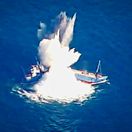The Ukrainians have started using drones with thermite charges, which really look like kites, spewing molten metal at the enemy.
Photo: AI
Ukrainian drones spewing fire or molten metal remind many of the dragons from the legendary book Game of Thrones. (illustrative photo)
The Ukrainian army has begun using new types of combat drones equipped with thermite charges, which pose a significant threat to Russian troops. These drones use a thermite mixture that contains aluminum powder and iron oxide, reaching a temperature of 2,000 to 3,000 degrees Celsius. This technology has its origins in the 19th century, when it was invented to weld railway tracks. It was used by German forces during both world wars, mainly as incendiary bombs. Today, Ukrainian drones with this technology can cause extensive damage to enemy personnel and materials
Nicknamed “dragon drones,” these thermite drones use a chemical reaction to create intense heat capable of burning through steel and other materials, according to a report on CNN in early September. Ukraine’s armed forces are now using it despite warnings from the United Nations, which warns of potentially massive damage and the risk of destroying civilian infrastructure.
A series of videos posted on social media, including Ukraine’s Defense Ministry’s Telegram, show low-flying drones hurling streams of fire — actually molten metal — at tree-lined positions held by Russia. Termites can burn through practically anything, including metal, and can also cause concrete to crack. Moreover, it is very difficult to extinguish.
We do not know the exact composition of thermite charges, but at one time ammunition charges usually contained a mixture of 50-80% thermite and auxiliary substances that improve the properties during production and use. Aerial bombs use thermite, which contains 24% pyroaluminum, 50% iron oxides and 26% barium nitrate. Nitrate additive lowers the ignition temperature of thermite to 500-700 degrees Celsius, gases produced during burning increase thermite’s ignition capabilities, and barium increases the fluidity of the slag. Part of the aluminum can also be replaced by magnesium.
The deployment of thermite drones also poses a challenge to defense systems, as these drones can be equipped with incendiary weapons and use different application methods, including direct dropping of an incendiary agent or the use of containers containing thermite and flammable liquid. Defense against these drones involves the use of electronic warfare systems that can suppress the drones’ navigation and control channels, preventing the delivery of combat payloads. If the drone cannot be suppressed by electronic means, small arms or portable anti-aircraft missiles can be used.

The Ukrainian army, faced with a shortage of traditional equipment and weapons, is looking for new and unconventional ways of conducting combat operations. The use of drones with thermite charges is one such innovative approach. However, the Russian army already has some experience and means of destroying enemy drones and is preparing to fight against this new threat.
These new Ukrainian thermite drones are capable of operating against different types of targets. Despite the fact that thermite weapons have already been used in the past, their use in modern conflicts raises new concerns in terms of humanitarian law and the protection of the civilian population, but they are not prohibited.
Source: vat.pravda.sk


